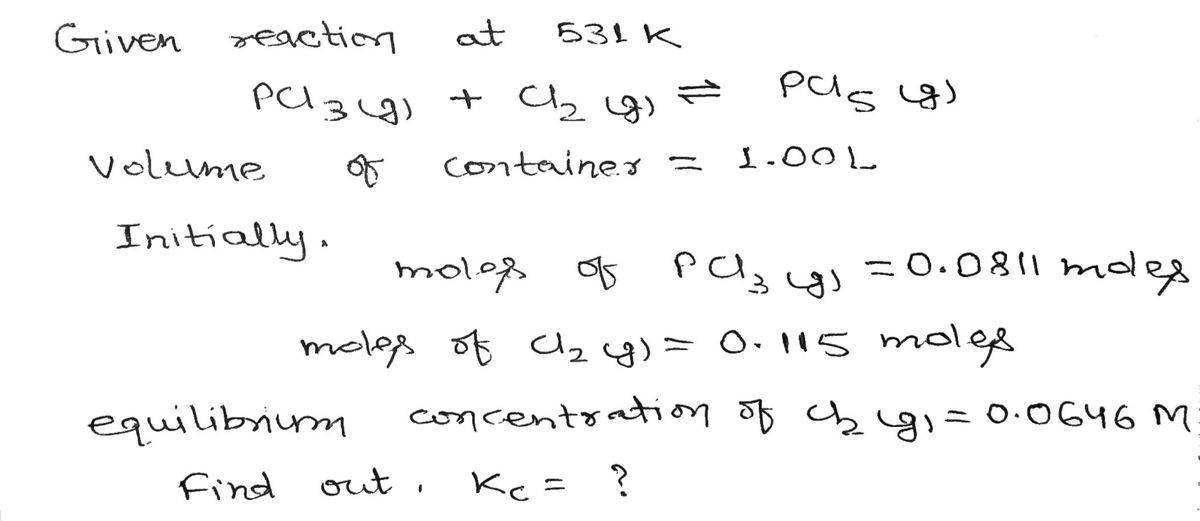Tabo PC13 (g) + Cl₂ (g) ⇒ PC15 (9) she introduced 0.0811 moles of PC13 (9) and d the equilibrium concentration of Cl₂ (g) to be late the equilibrium constant, Kc, she obtained
Tabo PC13 (g) + Cl₂ (g) ⇒ PC15 (9) she introduced 0.0811 moles of PC13 (9) and d the equilibrium concentration of Cl₂ (g) to be late the equilibrium constant, Kc, she obtained
Chemistry
10th Edition
ISBN:9781305957404
Author:Steven S. Zumdahl, Susan A. Zumdahl, Donald J. DeCoste
Publisher:Steven S. Zumdahl, Susan A. Zumdahl, Donald J. DeCoste
Chapter1: Chemical Foundations
Section: Chapter Questions
Problem 1RQ: Define and explain the differences between the following terms. a. law and theory b. theory and...
Related questions
Question
![A student ran the following reaction in the laboratory at 531 K:
\[ \text{PCl}_3 (g) + \text{Cl}_2 (g) \rightleftharpoons \text{PCl}_5 (g) \]
When she introduced 0.0811 moles of \(\text{PCl}_3 (g)\) and 0.115 moles of \(\text{Cl}_2 (g)\) into a 1.00 liter container, she found the equilibrium concentration of \(\text{Cl}_2 (g)\) to be 0.0646 M.
Calculate the equilibrium constant, \(K_c\), she obtained for this reaction.
\[ K_c = \boxed{\phantom{K}} \]](/v2/_next/image?url=https%3A%2F%2Fcontent.bartleby.com%2Fqna-images%2Fquestion%2F6e7279b6-864f-464c-a490-1592f397f56d%2F2d09893a-3d8d-4d7b-b8b0-e21ec2663200%2F0e7pi8x_processed.png&w=3840&q=75)
Transcribed Image Text:A student ran the following reaction in the laboratory at 531 K:
\[ \text{PCl}_3 (g) + \text{Cl}_2 (g) \rightleftharpoons \text{PCl}_5 (g) \]
When she introduced 0.0811 moles of \(\text{PCl}_3 (g)\) and 0.115 moles of \(\text{Cl}_2 (g)\) into a 1.00 liter container, she found the equilibrium concentration of \(\text{Cl}_2 (g)\) to be 0.0646 M.
Calculate the equilibrium constant, \(K_c\), she obtained for this reaction.
\[ K_c = \boxed{\phantom{K}} \]
![A student ran the following reaction in the laboratory at 427 K:
\[ \text{PCl}_5(g) \rightleftharpoons \text{PCl}_3(g) + \text{Cl}_2(g) \]
When she introduced 3.96 moles of \(\text{PCl}_5(g)\) into a 1.00 liter container, she found the equilibrium concentration of \(\text{Cl}_2(g)\) to be 0.0387 M.
Calculate the equilibrium constant, \(K_c\), she obtained for this reaction.
\[ K_c = \]](/v2/_next/image?url=https%3A%2F%2Fcontent.bartleby.com%2Fqna-images%2Fquestion%2F6e7279b6-864f-464c-a490-1592f397f56d%2F2d09893a-3d8d-4d7b-b8b0-e21ec2663200%2Farwifql_processed.png&w=3840&q=75)
Transcribed Image Text:A student ran the following reaction in the laboratory at 427 K:
\[ \text{PCl}_5(g) \rightleftharpoons \text{PCl}_3(g) + \text{Cl}_2(g) \]
When she introduced 3.96 moles of \(\text{PCl}_5(g)\) into a 1.00 liter container, she found the equilibrium concentration of \(\text{Cl}_2(g)\) to be 0.0387 M.
Calculate the equilibrium constant, \(K_c\), she obtained for this reaction.
\[ K_c = \]
Expert Solution
Step 1: Find out Kc for the reaction

Step by step
Solved in 3 steps with 3 images

Knowledge Booster
Learn more about
Need a deep-dive on the concept behind this application? Look no further. Learn more about this topic, chemistry and related others by exploring similar questions and additional content below.Recommended textbooks for you

Chemistry
Chemistry
ISBN:
9781305957404
Author:
Steven S. Zumdahl, Susan A. Zumdahl, Donald J. DeCoste
Publisher:
Cengage Learning

Chemistry
Chemistry
ISBN:
9781259911156
Author:
Raymond Chang Dr., Jason Overby Professor
Publisher:
McGraw-Hill Education

Principles of Instrumental Analysis
Chemistry
ISBN:
9781305577213
Author:
Douglas A. Skoog, F. James Holler, Stanley R. Crouch
Publisher:
Cengage Learning

Chemistry
Chemistry
ISBN:
9781305957404
Author:
Steven S. Zumdahl, Susan A. Zumdahl, Donald J. DeCoste
Publisher:
Cengage Learning

Chemistry
Chemistry
ISBN:
9781259911156
Author:
Raymond Chang Dr., Jason Overby Professor
Publisher:
McGraw-Hill Education

Principles of Instrumental Analysis
Chemistry
ISBN:
9781305577213
Author:
Douglas A. Skoog, F. James Holler, Stanley R. Crouch
Publisher:
Cengage Learning

Organic Chemistry
Chemistry
ISBN:
9780078021558
Author:
Janice Gorzynski Smith Dr.
Publisher:
McGraw-Hill Education

Chemistry: Principles and Reactions
Chemistry
ISBN:
9781305079373
Author:
William L. Masterton, Cecile N. Hurley
Publisher:
Cengage Learning

Elementary Principles of Chemical Processes, Bind…
Chemistry
ISBN:
9781118431221
Author:
Richard M. Felder, Ronald W. Rousseau, Lisa G. Bullard
Publisher:
WILEY